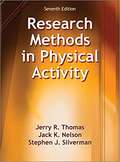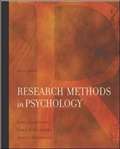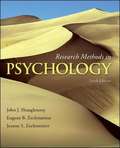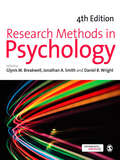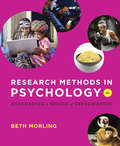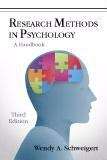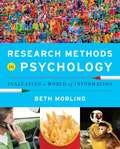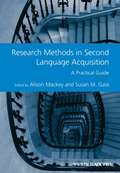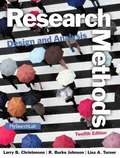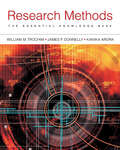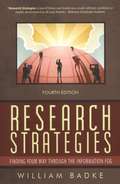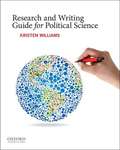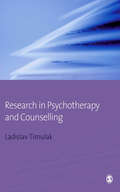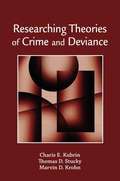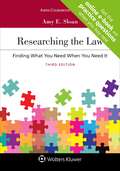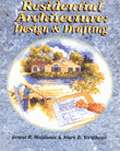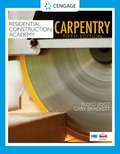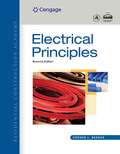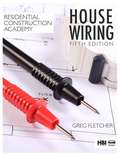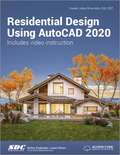- Table View
- List View
Research Methods in Physical Activity
by Stephen J. Silverman Jerry R. Thomas Jack K. NelsonResearch Methods in Physical Activity, Seventh Edition, systematically guides students through the research process, introducing methods and tools specifically for kinesiology and exercise science disciplines, including the subdisciplines of physical therapy, rehabilitation, and occupational therapy. The seventh edition leads students and novice researchers to research competency with the distinctive humor that has become a trademark of this internationally recognized text. <P><P> This text provides step-by-step information for every aspect of the research process, from identifying and devising research questions to analyzing data and compiling results for presentation. Methods for qualitative, quantitative, and mixed-methods research approaches are addressed, and real-world research questions—including historical, experimental, epidemiological, and philosophical—are presented by scholarly contributors who give suggestions for approaches to follow. Photos, anecdotes, and humorous stories are used throughout the text to put students at ease and emphasize key points through practical applications. Enhancements to the seventh edition include the following: • Updated information and techniques for electronic searches to ensure students use best research practices • New information on meta-analysis and the benefits of journal-style writing that teach readers to evaluate and prepare data for scholarly journals and publication • Special attention to ethical issues to help readers understand the regulations involved in using human and animal subjects • New information on logistic regression that aids in the understanding of complex ideas • Further explanation of qualitative and mixed-methods research approaches, in addition to quantitative approaches, to ensure readers use the most appropriate methodology for their research <P><P> The content of the seventh edition maintains and expands upon the logical content progression that has made Research Methods in Physical Activity the leading text in the field. <P><P> Part I presents an overview of the research process, including problem development, preparation of the research plan, and understanding ethical issues in research and writing. Part II introduces statistical and measurement issues in research, and part III presents various types of or approaches to research and methodology from expert researchers in the field. Part IV includes a writing guide for result findings and details how to develop and organize research papers and presentations. Statistical tables and guides are available in the appendix. <P><P> To aid instructors, Research Methods in Physical Activity, Seventh Edition, includes a suite of ancillary materials featuring an instructor guide, test package, an extra data set for instructors who wish to create specialized learning activities, and presentation package plus image bank. <P><P> Research Methods in Physical Activity, Seventh Edition, instills in students the confidence to devise, collect, analyze, and present their research in a competent manner by systematically guiding them through the research process. It is an essential text for all emerging researchers in physical activity.
Research Methods in Psychology
by Eugene B. Zechmeister John J. Shaughnessy Jeanne S. ZechmeisterConsidered one of the best undergraduate method texts in the field for the past two decades, Research Methods in Psychology captures the excitement of psychological inquiry as well as the importance of understanding the methodology that is used to conduct research. The text has been praised for its clear writing, logical organization, depth of coverage, and wide variety of examples from different fields of psychology. The new edition includes updated research, a thoroughly revised introductory chapter, and improved pedagogical features designed to enhance students' learning.
Research Methods in Psychology
by Eugene B. Zechmeister John J. Shaughnessy Jeanne S. ZechmeisterPsychologists use a variety of research methods and tools to learn about behavior and mental processes. The goal of this book is to introduce students to the “multimethod approach” to research in psychology, including observational, survey, and experimental methods. Students learn the strengths and weaknesses of each method, as well as ethical dilemmas when using them, so that they can become competent practitioners and thoughtful consumers of psychological research. Our approach is to engage students in the research process by describing contemporary research in psychology. Students learn about recent topics such as online dating and Facebook, cross-cultural observations of helping behavior, PTSD in orphaned chimpanzees, Medicaid and Medicare health outcomes, decision-making during Hurricane Katrina, clinical research and DSM-5, and much more. Each chapter's “stretching exercises,” “stat tips,” review questions, and challenge questions develop students' critical thinking about the psychological research that appears in scientific journals and in popular media. Together with the companion Online Learning Center for students, the 10th edition of Research Methods in Psychology provides a clearly written, compelling introduction to research methods in psychology.
Research Methods in Psychology
by Paul C. PriceYears before this book was a Flat World Knowledge textbook, Paul Price wrote an extensive series of handouts to replace the textbook he had been using for his psychological research methods course, and he posted them online for his students. The advantages of this were that 1) students had a streamlined presentation of the most important methodological concepts in psychology, and 2) they could access it online for free. Paul turned his book into a proper textbook by having it reviewed, edited and published with the full set of ancillaries by Flat World Knowledge so not only could his students get the materials for free, but so could yours. Although the content of Research Methods in Psychology is fairly traditional--making it easy for you to use with your existing courses--it also emphasizes a fundamental idea that is often lost on undergraduates: research methods are not a peripheral concern in our discipline; they are central. This why the overarching goal of this textbook is to present the basics of psychological research methods--focusing on the concepts and skills that are most widely shared within the discipline--emphasizing both their centrality to our field and their contribution to our understanding of human behavior. The book will include several features that will help accomplish this overarching goal. The Core Concepts: Dr. Price based his choices about content and terminology on the most influential original books and articles in the research methodology literature--as determined by an empirical analysis of the reference lists of secondary sources. He also relied on the Undergraduate Psychology Major Learning Goals and Outcomes document commissioned by the APA. Although many of the research methods outcomes in that document are addressed in all research methods textbooks (e.g., "Describe how various research designs address different types of questions and hypotheses"), others are rarely mentioned (e.g., "Recognize the limitations of applying normative conclusions to individuals"). The Examples: The text includes examples drawn from the entire range of contemporary psychology, including abnormal, clinical, and counseling psychology. Dr. Price also chose examples to show how psychological research has fundamentally changed what we believe to be true about human behavior (for example, in the area of eyewitness memory). The Style: Dr. Price concentrated on making the style of this book both straightforward and engaging. If you are looking for a new research methods textbook for your psychology course that has been used by "teachers" and is thorough in its content, you will find your book in Paul Price's Research Methods in Psychology. Order a desk copy and see for yourself.
Research Methods in Psychology (Fourth Edition)
by Jonathan A. Smith Daniel B. Wright Glynis BreakwellResearch Methods in Psychology has been substantially revised in its fourth edition. Continuing to offer enviable coverage of the research methods that psychology students at intermediate levels need to cover in their course, the textbook has now been broadened to cover the full suite of beginner level research methods too. The result is extensive coverage of psychological methods, both quantitative and qualitative, and a textbook that will serve students perfectly from day one in their course at university.<P><P> Research Methods in Psychology in its fourth edition includes: <P> * Extended statistical coverage, including new chapters on Descriptive Statistics, Inferential Statistics, ANOVA, Regression and Correlation, and Latent Variable Models<P> * Further New Chapters on Content Analysis and Writing up your Research<P> * New introductory sections placing each method in context and showing students how they relate to the bigger 'real world' picture. <P> * Intuitive structure and visual layout makes the book easy to navigate so you can quickly find the content you need.<P> This textbook is ideal for beginner and intermediate level psychological research methods students worldwide.<P> Visit the Research Methods in Psychology companion website www.sagepub.co.uk/breakwell4e to take advantage of additional resources for students and lecturers.
Research Methods in Psychology (Second Edition)
by Beth MorlingThis market-leading text emphasizes future consumers of psychological research, uses real-world examples drawn from popular media, and develops students’ critical-thinking skills as they become systematic interrogators of information in their everyday lives
Research Methods in Psychology: A Handbook
by Wendy A. SchweigertThis handbook provides a brief but thorough introduction to the most commonly used research methods in psychology (as well as a number of related topics such as statistics, ethics, and literature searches). The book includes much of the same information presented in longer texts, but in a more succinct format.
Research Methods in Psychology: Evaluating a World of Information
by Beth MorlingEven though few psychology majors end up pursuing a career as a researcher in the field, Morling (U. of Delaware) wants to enable them to become critical consumers of research. Rather than the typical research methods text emphasis on research production, she concentrates on tools for evaluating research claims. The text features a "Three Claims, Four Validities" framework for identifying and evaluating claims; learning activities; and overviews of descriptive statistics, inferential statistics, presenting research reports in APA style; statistical tables; and a glossary. Annotation ©2012 Book News, Inc. , Portland, OR (booknews. com)
Research Methods in Second Language Acquisition: A Practical Guide
by Alison Mackey Susan M. GassResearch Methods in Second Language Acquisition: A Practical Guideis an informative guide to research design and methodology for graduate students and scholars. Each chapter of this volume offers background, step-by-step guidance, and relevant studies to create comprehensive coverage of each method. Includes chapters by expert scholars on an array of topics, including second language writing and reading, meta-analyses, research replication, qualitative data collection and analysis, and more Includes feature boxes in each chapter highlighting relevant research studies, discussion questions and suggested further readings Utilizes research methods and tools from varied fields of study including education, linguistics, psychology, and sociology
Research Methods, Design, and Analysis (Twelfth Edition)
by Larry B. Christensen R. Burke Johnson Lisa A. TurnerResearch Methods, Design, and Analysis, 12/e, provides an understanding of the research methods used to investigate human thought and behavior. The coverage of experimental, qualitative, correlational, and survey research helps students develop their research skills for all aspects of psychology. Information is presented in a simple and straightforward manner and placed into context of actual research studies, helping students make real-life connections.
Research Methods: Concepts and Connections
by Michael PasserAt last, a fresh approach to the research methods course. With 20+ years experience teaching the course, Michael Passer knows what students understand and where they struggle. His highly anticipated new book, Research Methods: Concepts and Connections, offers students clear and compelling explanations and examples drawn from cutting-edge research from across the subfields of psychology. Readers come away with an unparalleled understanding of behavioral research practice in today’s world and how those skills apply to everyday life.
Research Methods: The Essential Knowledge Base
by James P. Donnelly William M. Trochim Kanika AroraFrom an expert team in the research methods field, RESEARCH METHODS: THE ESSENTIAL KNOWLEDGE BASE, 2nd Edition, is written specifically for users who are new to research methods. The book streamlines and clarifies explanations of fundamental, yet difficult, concepts in a familiar, engaging style. Readers learn about the relationship between theory and practice, which helps them become better researchers and better consumers of research.
Research Strategies: Finding Your Way Through the Information Fog 4th Edition
by William BadkeBecause of the dynamic nature of the Internet, any web addresses or links contained in this book may have changed since publication and may no longer be valid. The views expressed in this work are solely those of the author and do not necessarily reflect the views of the publisher, and the publisher hereby disclaims any responsibility for them.
Research and Writing Guide for Political Science
by Kristen WilliamsHow do we know why the Soviet Union decided to place missiles in Cuba? How do we know why North Korea invaded South Korea? How do we know why the U.S. decided to invade Iraq? <p><p> We know the answers to these questions because political science scholars did in-depth research and shared their findings. Conducting, presenting, and publishing research are all integral parts of being a political scientist. Students in political science courses are exposed to the research done by scholars. In turn, professors would like their students to become part of this community of scholars and will assign research papers so that students can demonstrate their knowledge of specific topics. <p> An indispensable resource, Research and Writing Guide for Political Science provides a brief primer on the basic skills required for writing an effective research paper. It covers conducting research (finding, evaluating, and using sources); the various parts of a research paper and how they should be organized; writing, rewriting, revising, and editing; and citing the research (footnotes, endnotes, bibliographies, reference lists, and different academic citation styles: MLA, APA, and Chicago). A conclusion offers a list of additional resources.
Research in Psychotherapy and Counselling
by Ladislav Timulak"Timulak's aims, to clarify research and its value for practice, and to alert people to its 'limitations and potential misuse', have certainly been achieved. This book deserves a place in every professional library and I recommend it to anyone who is interested in understanding more about research" - Therapy Today, May 2009 'An authoritative text, providing a first-rate outline of the specific methods that counselling and psychotherapy researchers use, and illustrated through a wealth of examples' - Professor Mick Cooper, Senior Lecturer in Counselling, University of Strathclyde 'The content is comprehensive and covers the full range of knowledge and information that a trainee psychologist/psychotherapy researcher would want to have... It offers a general overview of psychotherapy research methods and their logic which is not duplicated in any book that I know of' - Georgia Lepper, Senior Lecturer in Psychotherapy, University of Kent Research in Psychotherapy and Counselling is a guide to methods used in studying the outcomes and processes of therapy. Introducing a range of methodologies which are used internationally, the author describes different research designs and illustrates them through examples of actual studies. Presenting the findings from key studies, he clearly demonstrates the usefulness of the research in therapeutic practice. Research in Psychotherapy and Counselling is ideal for researchers and for students on courses in counselling, psychotherapy, clinical and counselling psychology and psychiatry. Ladislav Timulak is course director of the MSc in Counselling Psychology at Trinity College, Dublin. He previously worked at the University of Trnava, Slovakia, and has extensive practical experience in the field of counselling and psychotherapy, as well as experience in conducting psychotherapy training.
Researching Theories Of Crime And Deviance
by Marvin D. Krohn Charis E. Kubrin Thomas D. StuckyMany textbooks provide summaries and critiques of criminological theories, which are often supported by empirical evidence. However, this evidence is only as good as the research methods that were used to generate it. Where do these "facts" come from, and how reliable are they? <p><p> Researching Theories of Crime and Deviance offers a critical evaluation of the research methods that generate data, bridging the gap between theory and research in the study of crime and deviant behavior. This unique resource challenges students to carefully appraise--rather than blindly accept--the research techniques that are used to produce theories and scholarship. <p> In clear and engaging language, noted criminologists Charis E. Kubrin, Thomas D. Stucky, and Marvin D. Krohn assess the various research methods that have been used to test nine theoretical perspectives of crime. As they examine the processes and challenges of conducting theoretically directed research, the authors focus on sampling, measurement, and analytical issues. <p> A dynamic and compelling text, Researching Theories of Crime and Deviance demystifies the research process, encouraging students to become better informed readers and researchers. It serves as an excellent resource for criminological theory courses, graduate-level research methods courses, and seminars that take a close look at the development of criminological theory and/or methods.
Researching the Law: Finding What You Need When You Need It (Aspen Coursebook)
by Amy E. SloanResearching the Law: Finding What You Need When You Need It, Third Edition, guides students through a decidedly contemporary approach to legal research. Widely respected author Amy E. Sloan presents legal research as a process of efficiently filtering a vast quantity of available information. Simply put, students learn how to locate and identify the most pertinent and authoritative information available with the greatest possible expedience. Sloan's clear, concise explanations of essential research sources are presented in a context that speaks to the way lawyers do research today, with a flexible approach that works in a rapidly changing research environment. Part I explains how to define a research question; pre-filter content before beginning a search; conduct research using a variety of search techniques; and establish post-search criteria for filtering results. Part II describes essential features of individual sources of authority and search strategies unique to each source. Part III contains research flowcharts to help students plan research strategy for different types of research projects.
Researching the Sun-Earth-Moon System, Student Guide
by National Science Resources Center John Norton Amy CharlesNIMAC-sourced textbook
Residential Architecture: Design and Drafting
by Ernest R. Weidhaas Mark D. WeidhaasThis comprehensive text provides a complete overview for beginning and intemediate students. With equal emphasis on design and drafting, the book leads students through the design of a contemporary home from preliminary program to finished rendering, with plans included in relevant chapters. Applied academics are integrated throughout the text, applying math, social studies, science, and communication to the field of architectural drafting. Career profiles give students the perspective they need to plan their own careers. Beyond the basics, the text also explores such contemporary issues as environmental sensitivity, accessibility for the physically challenged, alternate energy sources, radon control, earthquake protection, and construction administration, to name a few. A complete set of plans exposes students to commercial construction. Features on computers and the Internet prepare students for the technological challenges they will encounter in the workforce. An ideal introduction to architectural drafting and design!
Residential Carpentry I: Foundations and Framing
by Nccer StaffThe material in this textbook will help you prepare for a career in residential carpentry.
Residential Construction Academy: Carpentry
by Floyd Vogt Gary BrackettCreated in partnership with the National Association of Home Builders (NAHB) and its Home Builders Institute (HBI), this best-selling resource uses a visual, practical, instructional approach to teach students how to build a home and help them develop essential workplace skills. RESIDENTIAL CONSTRUCTION ACADEMY: CARPENTRY, Fifth Edition, provides a logical, sequential introduction to essential construction topics. Each chapter begins with learning objectives and a glossary, features relevant pictures and diagrams to reinforce key ideas, and concludes with construction procedures and review questions. Throughout the text, the authors also highlight important techniques, tools, materials, code requirements, and best practices associated with constructing a residential building.
Residential Design Using Auto CAD 2020
by Daniel John StineResidential Design Using AutoCAD 2020 is an introductory level tutorial which uses residential design exercises as the means to teach you AutoCAD 2020. Each book comes with access to extensive video instruction in which the author explains the most common tools and techniques used when designing residential buildings using AutoCAD 2020. After completing this book you will have a well-rounded knowledge of Computer Aided Drafting that can be used in the industry and the satisfaction of having completed a set of residential drawings. <p><p> This textbook starts with a basic introduction to AutoCAD 2020. The first three chapters are intended to get you familiar with the user interface and the most common menus and tools. Throughout the rest of the book you will design a residence through to its completion. <p> Using step-by-step tutorial lessons, the residential project is followed through to create elevations, sections, details, etc. Throughout the project, new AutoCAD commands are covered at the appropriate time. Focus is placed on the most essential parts of a command rather than an exhaustive review of every sub-feature of a particular command. The Appendix contains a bonus section covering the fundamental principles of engineering graphics that relate to architecture. <p> This book also comes with extensive video instruction as well as bonus chapters that cover must know commands, sketching exercises, a roof study workbook and much more.
